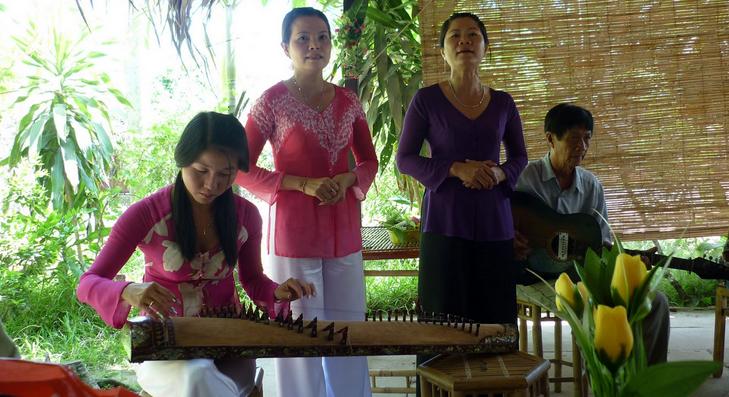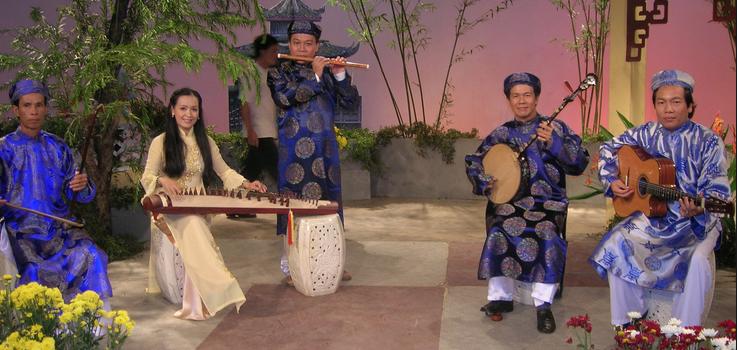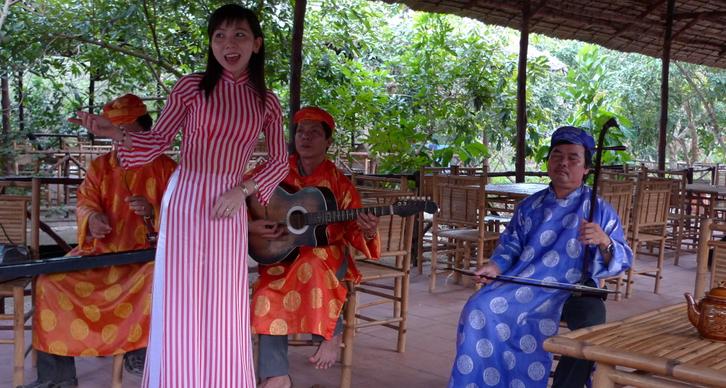Southern Vietnamese folk music
When you travel to Mekong Delta: Ben Tre, My Tho, Can Tho where is very famous for Don Ca Tai Tu – That is traditional music performance.
What is Don Ca Tai Tu?

Đờn ca tài tử is a musical art that has both scholarly and folk roots. It developed in southern Việt Nam in the late nineteenth century. The repertoire of Đờn ca tài tử is based on 20 principal songs (bài Tổ) and 72 classical songs (bài nhạc cổ). These songs consist of ‘skeletal melodies’ which are used as the basis for improvisation and variation. Đờn ca tài tử performers express feelings and sentiments by improvising, ornamenting and varying the ‘skeletal melody’ of pieces and the main rhythmic patterns.
Đờn ca tài tử is played on a variety of different instruments including the kìm (moon-shaped lute), cò (two-stringed fiddle), tranh (16-string zither), tỳ bà (pear-shaped lute), song lang (percussion), bầu (monochord) and sáo (bamboo flute), and the violin and guitar which were adapted. The guitar used by tài tử artists has a deep, hollowed-out finger board, enabling musicians to play special ornamentation characteristic of Đờn ca tài tử.
People in southern Việt Nam consider Đờn ca tài tử to be an indispensable spiritual cultural activity and a highly valued part of their cultural heritage. It is performed at numerous events such as festivals, ‘death anniversary’ rituals such as the Death Anniversary of the Ancestors held annually on the twelfth day of the eighth lunar month, and celebratory social events like weddings and birthdays. The audience can join practicing, making comments or creating new song texts.
Đờn ca tài tử was added to the National List of Intangible Cultural Heritage in 2012.

The musicians who contribute to Đờn ca tài tử include:
Master instrumentalists (Thày Đờn), who are highly skillful at playing and teaching numerous instruments and who have mastered all of the classical repertoire.
Master instrumentalists (Thày Đờn), who are highly skillful at playing and teaching numerous instruments and who have mastered all of the classical repertoire.
Master lyricists (Thày Tuồng), who are knowledgeable and experienced at composing new song texts.
Master singers (Thày Ca), who have mastered the classical repertoire and who can perform and teach the distinctive Đờn ca tài tử vocal techniques and ornamentation.
There are also regular instrumentalists (Danh cầm) and singers (Danh ca).
Famous Đờn ca tài tử artists include: Vĩnh Bảo (aged 96), Năm Thê (aged 97) and Bạch Huệ (aged 78) in Hồ Chí Minh City; Tám Kỳ (aged 68) in Long An province; Thanh Hiền (aged 70) in Tây Ninh province; Nguyễn Thiện Vũ (aged 34) in An Giang province.
Mr. Nguyễn Quang Đại (also known as Ba Đọi) and Mr. Lê Tài Khị (also known as Nhạc Khị) were famous masters who, after their deaths, were revered by the community and had shrines dedicated to them. They are considered to be the Late Ancestors (Hậu Tổ) of Đờn ca tài tử.
In the early 20th century, Mr. Cao Văn Lầu (also known as Sáu Lầu) composed the song Dạ cổ hoài lang (or Vọng cổ), which is the most famous song of Đờn ca tài tử. The structure of this piece changed as it was transmitted over time: its rhythmic structure changed from using 2-bar phrases, to 4-bar, 16-bar, 32-bar and 64-bar phrases.
Đờn ca tài tử is passed between generations through two methods:

1) The traditional method of oral transmission is known in Vietnamese as truyền ngón, truyền khẩu, which literally means “transmitting through the fingers and through the mouth”. For this traditional method, which is based on imitation, the master instrumentalists and singers directly teach students who are members of ensembles or clubs. This method has also been used especially to teach within family lines.
2) The second method combines traditional oral methods of transmission with a syllabus that has pieces written out in Western staff notation and Vietnamese note names. This method is used in many of the national and provincial schools of art and culture.
Instrumentalists must study for at least three years in order to learn basic instrumental techniques, such as tremolo, glissando, trills, vibrato, etc. They learn to perform solo or with other musicians in duets, trios, quartets, quintets or sextets. They must also master the different musical modes such as the Bắc, Hạ, Xuân, Ai and Oán modes to express different moods and emotions, such as feelings of happiness or sadness.
Vocal students, performing either solo or in a duet, study the traditional songs. They learn to subtly improvise using different ornamentation techniques in a way that is in keeping with the musical aesthetics of the musical community and is appropriate for the particular melody, mode and song text performed.
Đờn ca tài tử is a popular cultural activity that serves individuals and the community. It resonates with the lifestyle of southern people who work on the land and rivers of the delta region; it reflects their inner feelings and emotions, their industriousness, generosity and courage.
Đờn ca tài tử is a valuable cultural inheritance that combines influences from court music and folk music, and it has been influenced by cultural exchange with Khmer, Chinese and Western peoples.
Đờn ca tài tử practitioners always respect, love and learn from each other. This not only applies to the realm of artistic activity, but also to broader cultural behavior, which is based on good moral virtues. Đờn ca tài tử performers therefore make an important contribution to the beauty and greater good of the community and society at large. Đờn ca tài tử stimulates artistic creativity and enjoyment not only for practitioners themselves but also amongst the public in general.
Đờn ca tài tử performs an important function in the ritual activities and cultural practices of the community. The performance of Đờn ca tài tử also helps the community preserve other cultural practices and customs that are associated with festivals, oral culture, and handicrafts. Nowadays, Đờn ca tài tử is not only a cultural activity of the community, it also makes a contribution to sustainable tourism in the local area.
Đờn ca tài tử practice, creativity, appreciation and transmission between generations does not violate human rights because everybody can voluntarily and equally take part in the artistic activities regardless of ethnic group, social class, religious belief, age, gender and occupation.
Originating from the diverse traditional culture of communities in central and southern Việt Nam, Đờn ca tài tử has long been an important part of the social and cultural life of the Việt people. It is respected and accepted by the communities who take part in performances and their artistic creativity contributes to cultural diversity. Đờn ca tài tử is constantly being renewed and supplemented through cultural influences from other ethnic groups.
Đờn ca tài tử is a cultural activity that connects communities: it expresses mutual respect and harmony between different communities, groups and individuals, and acts as a foundation for sustainable development.
www.impresstravel.com
OTHER NEWS
- Khmer community in Hau Giang, Soc Trang celebrate Sene Dolta festival (11/10/2018)
- River Culture in Mekong Delta (07/06/2018)
- Full moon (Mid-Autumn) Festival (23/08/2017)
- Ong pagoda festival in Can Tho (12/06/2017)



